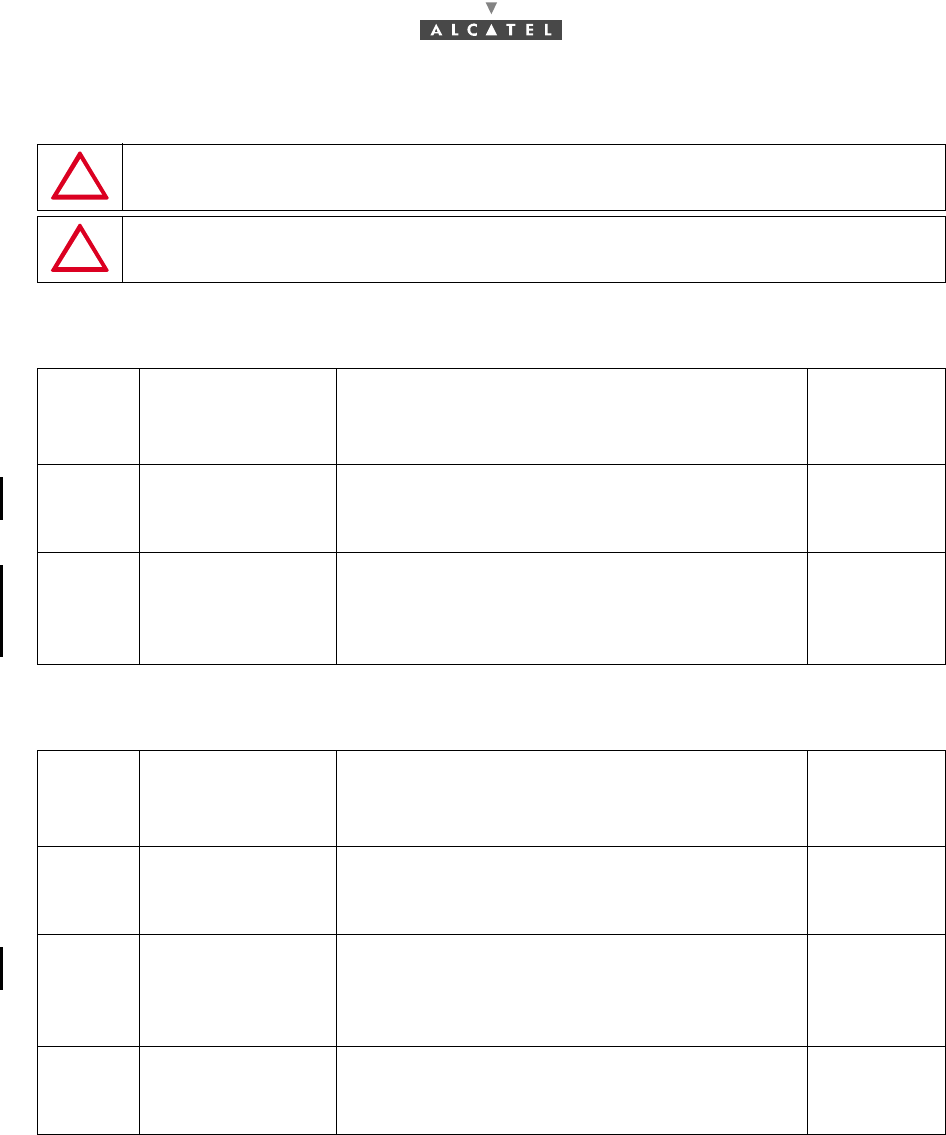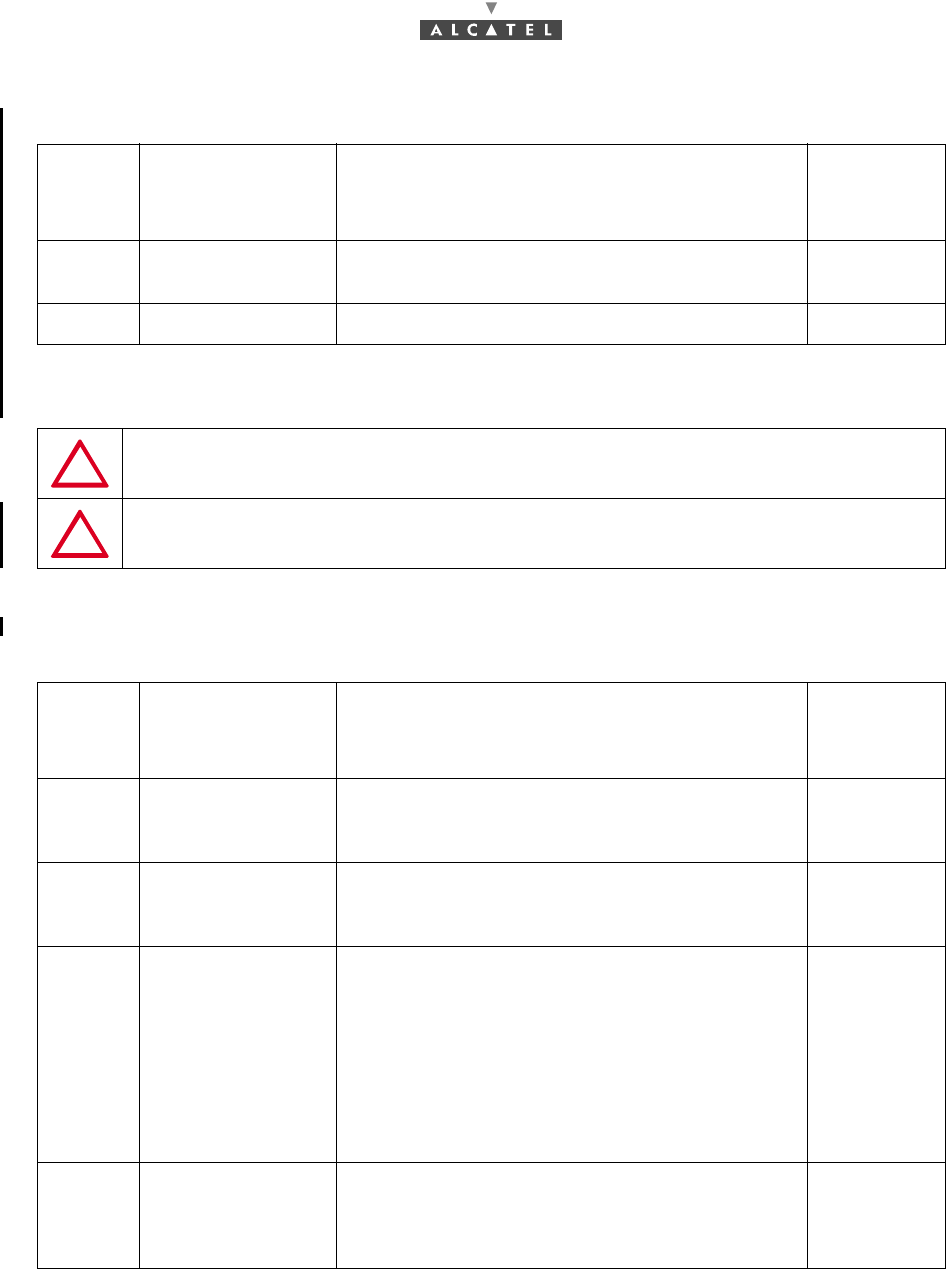Alcatel Canada 24T28A01D22C 7390 24 GHz Co-Pol RBS User Manual BS Manual pages 191 to 228
Alcatel Canada Inc 7390 24 GHz Co-Pol RBS BS Manual pages 191 to 228
Contents
- 1. BS Manual pages 1 to 16
- 2. BS Manual pages 17 to 30
- 3. BS Manual pages 31 to 40
- 4. BS Manual pages 41 to 45
- 5. BS Manual pages 46 to 50
- 6. BS Manual pages 51 to 55
- 7. BS Manual pages 56 to 60
- 8. BS Manual pages 61 to 70
- 9. BS Manual pages 71 to 76
- 10. BS Manual pages 77 to 125
- 11. BS Manual pages 126 to 182
- 12. BS Manual pages 183 to 190
- 13. BS Manual pages 191 to 228
- 14. BS Manual pages 229 to 246
- 15. BS Manual pages 247 to 276
- 16. BS Manual pages 277 to 280
- 17. BS Manual pages 281 to 284
- 18. BS Manual pages 285 to 302
BS Manual pages 191 to 228

3CC12424AAAA TQ BJA 01 Issue 01 - April 2001 - Draft 04 191/302
228
6 Operation and maintenance
6.1 Network supervision
The status of the system is controlled permanently by the supervision function provided by the 7390LT
software. This function is described in § 4.4 Supervision Principles and 4.5 Base Station Supervision. It
offers the following operational help tools:
–a log of all the events taking place between the Agent (NE) and the Manager (7390 LT) from the
connection (see § 4.8 NE management),
–a historical event log (see § 4.8.3 Historical Event log)
–an alarms list (see § 4.10.1 Alarms).
6.2 Operation
The configuration operations relating to current operations are as follows:
–Time setting (see § The operator is advised of any inappropriate commands by error messages
(see Appendix 6 – Error messages and corrective actions).),
–Configuration of frequencies (see § 6.2.2 Configuration of frequencies),
–Configuration of transmit power level (see § 6.2.3 Configuration of transmit power level)
–Configuration of RBS (see § 6.2.4 Configuration of the RBS),
–Activation of upstream (see § 6.2.5 Activation of upstream),
–Validation of upstream for IP data traffic (see § 6.2.6 Validation of upstream for IP data traffic),
–Radio resources management (see § 6.2.7 On-demand Service Management),
–Configuration of IP addresses (see § 6.2.8 Configuration of IP addresses),
–Configuration of the NFS server (see § 6.2.9 Configuration of the NFS Server),
–Configuration of ATM interface (see § 6.2.10 Configuration of ATM interface),
–Configuration of TNT board for circuit emulation (see § 6.2.11 Configuration of TNT board for cir-
cuit emulation),
–Creation of ASAP table for NT (see § 6.2.12 Creation of ASAP table for NT),
–Suppression of ASAP table for NT (see § 6.2.13 Suppression of ASAP table for NT),
–Change of alarm severity profile (see § 6.2.14 Change of alarm severity profile),
–Service creation: leased lines, data and/or VoIP (Voice over IP), IP, CES, ISDN (see § 6.2.15 Ser-
vice creation leased lines, IP, CES, ISDN),
–Service suppression: leased lines, data and/or VoIP, CES, ISDN (see § 6.2.16 Service suppres-
sion leased lines, IP, CES, ISDN),
–Start radio performance for NT (see § 6.2.17 Start radio performance for NT),
–Stop radio performance for NT (see § 6.2.18 Stop radio performance for NT),
–Start radio performance for radio link (see § 6.2.19 Start radio performance for Radio Link),
–Stop radio performance for radio link (see § 6.2.20 Stop radio performance for Radio Link)
–Stop NE supervision (see § 6.2.21 Stop NE Supervision)
–Start NE supervision (see § 6.2.22 Start NE Supervision)
–Stop NT supervision (see § 6.2.23 Stop NT Supervision)

192/302 Issue 01 - April 2001 - Draft 04 3CC12424AAAA TQ BJA 01
228
–Start NT supervision (see § 6.2.24 Start NT Supervision)
–Stop BS supervision (see § 6.2.25 Stop BS Supervision)
–Start BS supervision (see § 6.2.26 Start BS Supervision)
–Backup (see § 6.2.27 Backup),
–Restore (see § 6.2.28 Restore).
Note: The operator is advised of any inappropriate commands by error messages (see Appendix 6 –
Error messages and corrective actions).
6.2.1 Time setting
6.2.1.1 Manual time setting
Time setting is carried out from the BS Details screen (see § 4.5 Base Station Supervision) by clicking
on the «Set Agent time» button (see § 4.5.5 Sending time to the Agent). The system updates its time
only when manual time setting is done.
Note: Manual time setting is not allowed when SNTP server is configured.
6.2.1.2 Automatic Time Setting by SNTP
Note: Once the automatic time setting is set, the system updates its time every fifteen minutes with the
SNTP server time.
6.2.2 Configuration of frequencies
Order
number
of steps Designation Comments Refer to
paragraph
concerned
I Configuration of
the IP address of
SNTP server.
Go to the Time Management screen and configure
an IP address time server. 4.14.4
II Check that SNTP
server is available. Check that the time server loss alarm has
disappeared. 4.10.1.3
Order
number
of steps Designation Comments Refer to
paragraph
concerned
I Access to the
Radio Configura-
tion screen.
Go to the Radio Configuration screen from the
BS Details screen. 4.5
II Definition of the
radio parameters. In the Radio Configuration screen:
- select the radio link tab,
- define the channelization type
- define the frequency of the uplink channel,
- define the frequency of the downlink channel,
- validate.
4.7

3CC12424AAAA TQ BJA 01 Issue 01 - April 2001 - Draft 04 193/302
228
6.2.3 Configuration of transmit power level
6.2.4 Configuration of the RBS
CHECK THAT THE FREQUENCIES ENTERED CORRESPOND TO THE DATA
OF THE IMPLEMENTATION SHEET (SEE Appendix 1 – Installation sheet).
THE SECTOR REBOOTS, FOR THIS SECTOR, THE SERVICES ARE
TEMPORARILY UNAVAILABLE.
Order
number
of steps Designation Comments Refer to
paragraph
concerned
I Access to the
Radio Configura-
tion screen.
Go to the Radio Configuration screen from the
BS Details screen. 4.5
II Selection of the
transmit power
level.
In the Radio Configuration screen:
- select the radio link tab,
- select the radio transmit power level,
- validate.
4.7.1
Order
number
of steps Designation Comments Refer to
paragraph
concerned
I Access to the confi-
guration of an RBS. In the BS Details screen, double-click on the RBS
whose radio parameters are being configured.
The RBS Details screen appears.
4.5
4.5.7
II Definition of the
DBS / RBS link. In the RBS Details screen:
- define the cable type,
- define the cable length,
- validate and return to the BS supervision screen.
4.5.7
III Checking absence
of alarm In the Alarm List screen:
- check that there is no "board_configerror" alarm
linked to this RBS.
4.10.1.3

194/302 Issue 01 - April 2001 - Draft 04 3CC12424AAAA TQ BJA 01
228
6.2.5 Activation of upstream
The upstream activation allows to be able to create NT.
6.2.6 Validation of upstream for IP data traffic
The validation of upstream for IP data traffic allows to be able to create IP services (cf. § 4.7.2 Dynamic
Traffic Configuration).
Order
number
of steps Designation Comments Refer to
paragraph
concerned
I Access to the radio
screen. Go to the Radio Configuration screen from the
BS Details screen. 4.7.1
II Activation of the
upstream. In the Radio Configuration screen:
- select the upstream to be activated and apply. 4.7.1
Order
number
of steps Designation Comments Refer to
paragraph
concerned
I Edit the IP data
traffic configura-
tion.
Go to IP Data Traffic Configuration screen from
the BS Details screen. 4.7.2
II Validate on the
upstream. - click on the data traffic field for the right upstream
and select "YES" to repeat the same for the other
upstreams to be validated,
- validate the modification by clicking on «Apply».
4.7.2
III Check configured
bandwidth. Check on the IP Data Traffic Configuration
screen that the configured bandwidth has been
correctly decreased.
4.7.2

3CC12424AAAA TQ BJA 01 Issue 01 - April 2001 - Draft 04 195/302
228
6.2.7 On-demand Service Management
Note: When a service is created, the operator can check bandwidth use by displaying the use radio
resource (see stage III).
6.2.8 Configuration of IP addresses
IP configuration consists in defining:
–the IP addresses of the BS, corresponding to each of the ATM and Ethernet interfaces,
–the sub-nets of 7390 LT managers associated with the ATM and / or Ethernet interfaces.
6.2.8.1 IP addresses of the ATM and Ethernet interfaces of the BS
Order
number
of steps Designation Comments Refer to
paragraph
concerned
I Access the On-
demand Service
Management
screen
From the BS Details screen, access the On-
demand Service Management screen. 4.5
II Overbooking
configuration In the On-demand Service Management screen:
- choose the radio link to manage.
The different possible actions are:
- for the downstream channels:
- define the overbooking factor limits,
- select or no the policing.
- for each upstream channel:
- define the overbooking factor limits,
- select the Guaranteed MCR or allow a
degraded MCR.
- validate by pressing the «Apply» button.
4.7.3.2
III Display of allocated
radio resources From the BS Details screen, access to the used
On-demand Service Management screen.
- consult the radio resources reserved for the traffic
4.5
4.7.3
BOTH IP ADDRESSES MUST BELONG TO DIFFERENT SUB-NETS.
Order
number
of steps Designation Comments Refer to
paragraph
concerned
I Access to the IP
address parame-
ters of the BS.
Go to BS’s Local Networks screen from the
«Change IP address» button.4.5
4.9.2

196/302 Issue 01 - April 2001 - Draft 04 3CC12424AAAA TQ BJA 01
228
Note: IP address 0.0.0.0. is not rejected but the system remains with the former IP address.
6.2.8.2 Sub-net of Manager (7390 LT)
Note: The two sub-nets can be associated with the same interface.
II Allocation of an IP
address to the ATM
interface.
In the "ATM Network" part of the BS’s Local
Networks screen:
- enter the Pvi/Vci parameters,
- select the bit rate,
- validate.
Nota:This stage can be not performed. In this case
the IP interface remains not configured.
4.9.2
III Allocation of an IP
address to the
Ethernet port.
In the "Ethernet Network" part of the BS’s Local
Networks screen:
.- define the IP address,
- define the sub-net mask,
- enter the IP address of the router associated with
the Ethernet input,
- validate.
Nota:This stage can be not performed. In this case
the IP interface is configured with default IP
address of the BS (192 168 99.1).
4.9.2
IT IS RECOMMENDED TO CHANGE THE ADDRESSES OF THE BS WITH A LT
CONNECTED LOCALLY TO THE BS.
Order
number
of steps Designation Comments Refer to
paragraph
concerned
I Access to "Network
address" settings Go to the Target Network screen from the
«Change Network address» button. 4.5
4.9.3
II Definition of the
manager sub-net
associated with
interface 1.
In the "Interface 1" part:
- define the IP address,
- define the sub-net mask,
- define the interface associated with manager 1
(ATM or Ethernet),
- validate.
4.9.3
III Definition of the
manager sub-net
associated with
interface 2.
In the "Interface 2" part:
- define the IP address,
- define the sub-net mask,
- define the interface associated with manager 2
(ATM or Ethernet),
- validate.
4.9.3
Order
number
of steps Designation Comments Refer to
paragraph
concerned

3CC12424AAAA TQ BJA 01 Issue 01 - April 2001 - Draft 04 197/302
228
6.2.9 Configuration of the NFS Server
In order to keep a connection between a DBS and a NFS server (even after a DBS reset), it is possible
to configure the access to a NFS server. Once done, any board or NT with a wrong software version will
be automatically updated..
6.2.10 Configuration of ATM interface
The 155 MBPS interfaces must be configured. The 34 Mbps interface is not configurable.
6.2.10.1 Configuration of the 155 MBPS interface I
Order
number
of steps Designation Comments Refer to
paragraph
concerned
I Selection of a File
Server Type. Go to the NFS Server screen:
- select the File Server Type.
In case of 7390 LT Server, perform step II.
In case of External Server, perform step III.
4.14.1
II Selection of the file
which describes
the software confi-
guration (7390 LT
server).
In the NFS Server screen:
- click on the «Browse...» button,
- select the File descriptor in the File Browser
screen,
- click on the «Apply» button,
- then, close the File Browser screen.
Nota: In the NFS Server screen, Package Location
and File descriptor parameters are automatically
updated.
Do not perform step III and go to step IV.
4.14.1
III Configuration of
the file which des-
cribes the software
configuration
(external server).
In the NFS Server screen:
- assign an IP address to the external server,
- select Network Type (LAN or WAN),
- give a Package Location,
Nota: Be cautious of the upper and lower cases.
- give a File descriptor name.
4.14.1
IV Validate the NFS
Server configura-
tion.
- click on the «Connect» button to take into
account the NFS Server Configuration.
Nota: An error message can appear (cf: Appendix
6 – Error messages and corrective actions)
4.14.1
Order
number
of steps Designation Comments Refer to
paragraph
concerned
I Configuration of
the Medium Type. Go to the ATM Ports Details screen:
- select the Medium Type (sdh or sonet),
- click on «Apply».
4.9.1

198/302 Issue 01 - April 2001 - Draft 04 3CC12424AAAA TQ BJA 01
228
6.2.11 Configuration of TNT board for circuit emulation
6.2.12 Creation of ASAP table for NT
Note: The new ASAP table is created with severities equal to the severities of the NT default table.
Order
number
of steps Designation Comments Refer to
paragraph
concerned
I Lock all TNT Ports Go to the E1 cross-connection screen and open
the TNT port configuration screen
Lock all the ports
4.5.3.2
II Change the input
type of the TNT
board
Go to the TNT Details screen:
- select ATM,
- and «Apply».
Nota: This change will make the TNT board reset
4.5.3.2
III Check TNT
configuration - Check the TNT board becomes green again, 4.5.3.2
IV Configure
parameters for
circuit emulation
- Change parameters,
(Buf Max Size) and (Cdv Rx T) 4.5.3.2
FOR T1 «Cdv RxT» AND «Buf Max Size» PARAMETER MUST NOT BE SET TO
RESPECTIVELY 250 µs AND 375 µs (THE LOWEST VALUE).
Order
number
of steps Designation Comments Refer to
paragraph
concerned
I Access to ASAP
List screen. From the menu bar, open ASAP List screen. 4.10.2
II Create a new
ASAP. - click on the «New ASAP» button,
- enter the new ASAP name.
- validate
4.10.2.1
III Change the alarm
severity profile. - click on the severity to be changed to make
appear scroll down list.
- click on the «Modify ASAP» button
- select the new severity.
- repeat this action for the severities to be chan-
ged.
- finally, validate by clicking on «Apply».
4.10.2.2

3CC12424AAAA TQ BJA 01 Issue 01 - April 2001 - Draft 04 199/302
228
6.2.13 Suppression of ASAP table for NT
Note: No NT must reference the ASAP table to be suppressed.
6.2.14 Change of alarm severity profile
IV Association of
these ASAPs to
NTs.
Go to NT List screen.
- double click on the first NT in the NT Details
screen.
- select wanted ASAP and validate by clicking on
«Apply».
- repeat these actions for the NT whose ASAP
table has to be changed.
4.6
Order
number
of steps Designation Comments Refer to
paragraph
concerned
I Select the ASAP. Go to the ASAP List screen, select the ASAP. 4.10.2
II Remove
suppression. - click on the «delete ASAP» button and confirm
the suppression by clicking on the «OK» button. 4.10.2.3
Order
number
of steps Designation Comments Refer to
paragraph
concerned
I Select the ASAP - Go to the ASAP List screen, select the ASAP.
- Click on «Modifiy ASAP» button.4.10.2
II Change severity of
a label. - Click on the severity to be changed to make
appear scroll down list.
- Select the new severity. Repeat this action for
the severities to be changed.
- Finally, validate by clicking on «Apply».
4.10.2.2
Order
number
of steps Designation Comments Refer to
paragraph
concerned

200/302 Issue 01 - April 2001 - Draft 04 3CC12424AAAA TQ BJA 01
228
6.2.15 Service creation leased lines, IP, CES, ISDN
Several cases may be distinguished according to whether leased lines (E1, X21, T1, CES) or IP cross-
connect creation is involved.
6.2.15.1 Creating an E1 cross-connection
Note: When a E1 port or E1 cross-connection is locked or unlocked a SIA alarm can appear temporarely.
Order
number
of steps Designation Comments Refer to
paragraph
concerned
I Configuration of
TNT port on BS Go to the E1 cross-connections screen:
- select the TNT board,
- access the configuration of the TNT board ports,
- select a port from the list,
- configure the port:
.select structured or unstructured,
.validate by clicking on «Apply».
.unlock the administrative status of the port,
.validate by clicking on «Apply».
4.12.1.2
4.12.1.3
4.12.1.4
II Configuration of
port on NT Go to the E1 cross-connections screen:
- select the NT,
- access the configuration of the NT ports,
.select structured or unstructured,
.validate by clicking on «Apply».
.unlock the administrative status of the port,
.validate by clicking on «Apply».
4.12.1.3
4.12.1.5
III Cross-connection
of timeslots of
selected ports
In the E1 cross-connections screen:
- two cross-connect modes are available
depending on whether the cross-connection ports
are structured or unstructured.
- validate the cross-connection by creating the E1
cross-connection (following step).
4.12.1.6
IV Creation of an E1
link In the E1 cross-connections screen:
- click on the cross-connection creation button.
In the Create a cross-connection screen:
- assign a designation to the cross-connection if
you want to modify the default designation.
- click on «OK»to create the link.
4.12.5.3
V Unlocking and
activating the
cross-connection
In the E1 cross-connections screen:
- click on the «Unlock» button. 4.12.5.5

3CC12424AAAA TQ BJA 01 Issue 01 - April 2001 - Draft 04 201/302
228
6.2.15.2 Creating an X21 cross-connection
Order
number
of steps Designation Comments Refer to
paragraph
concerned
I Configuration of
TNT port on BS Go to the E1 cross-connections screen:
- select the TNT board,
- access the configuration of the TNT board ports
- select a port from the list,
- configure the port:
.select structured or unstructured,
.validate by clicking on «Apply»
.unlock the administrative status of the port,
.validate by clicking on «Apply».
4.12.2.3
4.12.2.4
II Configuration of
port on NT Go to the E1 cross-connections screen:
- select the NT,
- access the configuration of the NT ports,
.unlock the administrative status of the port,
.validate by clicking on «Apply».
4.12.2.3
4.12.2.5
III Cross-connection
of time slots of
selected ports
In the E1 cross-connections screen:
- two cross-connect modes are available
depending on whether the cross-connection ports
are structured or unstructured.
- validate the cross-connection by creating the X21
cross-connection (following step).
4.12.2.6
IV Creation of an X21
link In the E1 cross-connections screen:
- click on the cross-connection creation button.
In the Create a cross-connection screen:
- assign a designation to the cross-connection if
you want to modify the default designation.
- click on «OK» to create the link.
4.12.5.3
V Unlocking and
activating the
cross-connection
In the E1 cross-connections screen:
- click on the «Unlock» button. 4.12.5.5

202/302 Issue 01 - April 2001 - Draft 04 3CC12424AAAA TQ BJA 01
228
6.2.15.3 Creating a T1 cross-connection
Order
number
of steps Designation Comments Refer to
paragraph
concerned
I Configuration of
TNT port on BS Go to the T1 cross-connections screen:
- select the TNT board,
- access the configuration of the TNT board ports,
- select a port from the list,
- configure the port:
.unlock the administrative status of the port,
.validate by clicking on «Apply».
4.12.3.3
4.12.3.4
II Configuration of
port on NT Go to the T1 cross-connections screen:
- select the NT,
- access the configuration of the NT ports,
- go to the Ports Configuration screen,
.select structured or unstructured,
.validate by clicking on «Apply».
.unlock the administrative status of the port,
.validate by clicking on «Apply».
4.12.3.3
4.12.3.5
III Cross-connection
of time slots of
selected ports
In the T1 cross-connections screen:
- two cross-connect modes are available
depending on whether the cross-connection ports
are structured or unstructured.
- validate the cross-connection by creating the T1
cross-connection (following step).
4.12.3.6
IV Creation of a T1
link In the T1 cross-connections screen:
- click on the cross-connection creation button.
In the Create a cross-connection window:
- assign a designation to the cross-connection if
you want to modify the default designation.
- click on «OK» to create the link.
4.12.5.3
V Unlocking and
activating the
cross-connection
In the T1 cross-connections screen:
- click on the «Unlock» button. 4.12.5.5

3CC12424AAAA TQ BJA 01 Issue 01 - April 2001 - Draft 04 203/302
228
6.2.15.4 Creating a CES cross-connection
Note: The TNT board must be configured for circuit emulation.
Order
number
of steps Designation Comments Refer to
paragraph
concerned
I Creation of LL
cross-connection See step I, II, III, IV of section 6.2.15.1( E1),
6.2.15.2 (X21) and 6.2.15.3 (T1)
II Check if the TNT
port is locked Go to the E1 cross-connections screen:
- select the TNT board,
- access the configuration of the TNT board ports,
- select a port from the list,
- lock the administrative status of the port,
- validate by clicking on «Apply».
4.12.6.3
III Creation of a CES
link - select the TNT board,
- select a TNT port from the list.
- choose the Vci of ATM link
- click on the «Cross-connection Creation» button.
4.12.6.3
IV Unlock the TNT
port Go to the E1 cross-connections screen:
- select the TNT board,
- access the configuration of the TNT board ports,
- select a port from the list,
- unlock the administrative status of the port,
- validate by clicking on «Apply».
4.12.4.3
V Unlock the LL
cross-connection
or unlock NT port
In the E1 cross-connections screen:
- click on the «unlock» button.
Go to the E1 cross-connections screen:
- select the NT,
- access the configuration of the NT ports,
- unlock the administrative status of the NT ports,
- validate by clicking on «Apply»
4.12.5.5
4.12.3.5(E1)
4.11.2.5
(X21)
4.12.3.5 (T1)

204/302 Issue 01 - April 2001 - Draft 04 3CC12424AAAA TQ BJA 01
228
6.2.15.5 Creating an IP cross-connection
Note: Before creating an IP cross-connection, check if upstream is validated for data traffic.
Order
number
of steps Designation Comments Refer to
paragraph
concerned
I Configuration of
Ethernet ports on
NT
Go to IP screen from main screen.
- go to NT Ethernet Ports Management screen
from the IP screen,
- select the NT,
- select the Configuration State (half or full duplex),,
- unlock the port,
- validate by clicking on «Apply».
4.13
4.13.2.2
II Creation of an IP
link Go to New IP Cross-connection screen from the
IP screen,
- select the NT involved in the IP link,
- select the Ethernet port involved in the link,
- select the IP service type (dynamic or static),
- define the flow in transmission and reception,
- select the traffic type (Only Data or Both Data &
Voice),
- enter the VCL parameters(Vpi, Vci ) for Data
traffic and for Voice over IP if needed.,
4.13.2.1 and
4.13.2.3
4.13.2.3
table
III Unlocking and
activating the IP
cross-connection
In the IP screen, click on the «Unlock» button. 4.13.2.6

3CC12424AAAA TQ BJA 01 Issue 01 - April 2001 - Draft 04 205/302
228
6.2.15.6 Creating an ISDN Servic.
Order
number
of steps Designation Comments Refer to
paragraph
concerned
I Configuration of
TNT port on BS Go to the ISDN cross-connections screen:
- select the TNT board,
- access the configuration of the TNT board ports,
- go to the ISDN ports Configuration screen:
- select a port from the list,
- configure the port with ISDN:
.validate by clicking on «Apply»,
.unlock the administrative status of the port,
.validate by clicking on «Apply».
4.12.2.3
4.12.4.3
II Creation of an
ISDN signaling
Link (for D
channels)
Go to the ISDN cross-connections screen:
- select signaling,
- select one TS of TNT port,
- assign the TS to the signaling TS,
- click on the cross connection creation button.
4.12.4.2
4.12.1.6
III Activation the
cross-connection In the ISDN cross-connections screen:
- click on the «Unlock» button. 4.12.4.3
IV Configuration of
TNT port on BS Go to the ISDN cross-connections screen:
- select the TNT board,
- access the configuration of the TNT board ports,
- select a port from the list,
- configure the port with ISDN:
.validate by clicking on «Apply»,
.unlock the administrative status of the port,
.validate by clicking on «Apply».
V Creation of an
ISDN Link (for B
channels)
Go to the E1 cross-connections screen:
- select the NT,
- select the NT ISDN port
- select one opr two TS of TNT port,
Nota: If only one B channel is inlvolved in the ISDN
link, select only one TS if both B channels or
involved, select two TSs.
- assign the TS to the B channel TS,
- click on the «Cross-connection Creation» button.
4.12.4.2
VI Activation of the
ISDN Link In the E1 cross-connections screen:
- select the ISDN Link
- click on the «Unlock» button.
4.12.4.2
VII Creation of an
ISDN Link over
another ISDN port
- repeat step IV to VI for the following ISDN port, 4.12.4.2

206/302 Issue 01 - April 2001 - Draft 04 3CC12424AAAA TQ BJA 01
228
Note: In the case of modifying the amount of enabled BRA-ISDN port at any WW-NT\ISDN, its existing
cross-connection for B-channels transport has to be removed and a new one has to be created
according to the new condition. This could even cause other cross-connections to be re-alloca-
ted (removed-created) in order to provide for enough bearer capacity in consecutive time slots at
a certain GXDI E1 link.
Note: A 7390 platform identifies n*64 Kbits/s transport services, not presenting any link with ISDN rela-
ted resources (i.e. OWSA-channels, B channels).
•One free time slot of the selected TNT port in ISDN configuration can be cross-connected to
the signalling time-slot on the NT side.
•It is not possible to create a B-channel ISDN cross-connection if there is not created first a
signalling cross-connection.
•It is possible to cross-connect up to 8 free time-slots of the selected port and up to 8 B-
channels of the 4 ISDN-BA user port, but just 1 cross-connection by NT port. Then, it is pos-
sible to have 4 B-channel cross-connections by port.
•2 cross-connections cannot coexist over the same NT port. So, if there is a B1 cross-con-
nection and the user wants to do a B1+B2 cross-connection, he has to remove the B1
cross-connection before creating the B1+B2 cross-connection.

3CC12424AAAA TQ BJA 01 Issue 01 - April 2001 - Draft 04 207/302
228
6.2.16 Service suppression leased lines, IP, CES, ISDN
Several cases may be distinguished according to whether leased lines (E1, X21, T1, CES) or IP cross-
connect suppression is involved.
6.2.16.1 Suppression of an E1 cross-connection
6.2.16.2 Suppression of an X21 cross-connection
Order
number
of steps Designation Comments Refer to
paragraph
concerned
I Locking the
cross-connection In the E1 cross-connection screen:
- select the cross-connection to suppress
- click on the «Lock» button.
4.12.5.5
II Locking the ports
used in the cross-
connection
In the Board TNT x : ISDN ports configuration:
- lock the relevant TNT port
- click on «Apply».
In the NT Board: E1 ports configuration:
- lock the relevant NT port,
- click on «Apply».
4.12.4.3
4.12.1.5
III Suppression of E1
cross-connection Once the "cross-connection" is selected in the
"cross-connections" list:
- click on the «Suppress» button of the toolbar
- validate the confirmation screen
- check that the suppressed "cross-connection" no
longer appears in the "cross-connections" list.
4.12.5.6
Order
number
of steps Designation Comments Refer to
paragraph
concerned
I Locking the
cross-connection In the E1 cross-connection screen:
- select the X21 "cross-connection" to be sup-
pressed
- click on the «Lock» button
4.12.5.5
II Locking the ports
used in the
cross-connection
In the Board TNT x : ISDN ports configuration:
- lock the relevant TNT board port
- click on «Apply».
In the NT Board: X21 ports configuration:
- lock the relevant NT port
- click on «Apply».
4.12.4.3
4.12.1.5
III Suppression of
X21
cross-connection
Once the "cross-connection" is selected in the
"cross-connections" list:
- click on the «Suppress» button of the toolbar
- validate the confirmation screen
- check that the suppressed "cross-connection" no
longer appears in the "cross-connections" list.
4.12.5.6

208/302 Issue 01 - April 2001 - Draft 04 3CC12424AAAA TQ BJA 01
228
6.2.16.3 Suppression of a T1 cross-connection
Order
number
of steps Designation Comments Refer to
paragraph
concerned
I Locking the
cross-connection In the T1 cross-connection screen:
- select the cross-connection to suppress
- click on the «Lock» button.
4.12.5.5
II Locking the ports
implemented in the
cross-connection
In the Board TNT x : ISDN ports configuration:
- lock the relevant TNT board port
- click on «Apply».
In the NT Board: T1 ports configuration:
- lock the relevant NT port
- click on «Apply».
4.12.4.3
4.12.1.5
III Suppression of T1
cross-connection Once the "cross-connection" is selected in the
"cross-connections" list:
- click on the «Suppress» button of the toolbar
- validate the Confirmation screen
- check that the suppressed "cross-connection" no
longer appears in the "cross-connections" list.
4.12.5.6

3CC12424AAAA TQ BJA 01 Issue 01 - April 2001 - Draft 04 209/302
228
6.2.16.4 Suppression of a CES cross-connection
DO NOT UNLOCK A PORT OF A TNT CONFIGURED FOR CES WITHOUT HAVING
ASSOCIATED E1 CROSS-CONNECTION TO THE PORT AND WITHOUT HAVING
UNLOCKED THIS E1 CROSS-CONNECTION BEFORE.
Order
number
of steps Designation Comments Refer to
paragraph
concerned
I Lock the TNT port
(Necessary before
suppressing
the CES
cross-connection)
In the Board TNT x : ISDN ports configuration:
- lock the relevant TNT board port
- click on «Apply».
4.12.4.3
II Suppression
of the CES
cross-connection
In the Circuit Emulation Service screen:
- select the "cross-connection" to be suppressed
- click on the «Suppress» button
- validate the Confirmation screen
- check that the suppressed "cross-connection" no
longer appears in the "cross-connections" list.
4.12.6.3
4.12.6.4
III Lock of NT ports
lock of LL
cross-connection
In the NT Board: xx ports configuration:
- lock the relevant NT port
- click on «Apply».
In the xx Cross-connection screen:- select the
cross-connection to suppress
- click on the «Lock» button.
4.12.1.5
4.12.5.5
IV Suppression of LL
cross-connection Once the "cross-connection" is selected in the
"cross-connections" list:
- click on the «Suppress» button of the toolbar
- validate the Confirmation screen
- check that the suppressed "cross-connection" no
longer appears in the "cross-connections" list.
4.12.5.6

210/302 Issue 01 - April 2001 - Draft 04 3CC12424AAAA TQ BJA 01
228
6.2.16.5 Suppression of an IP cross-connection
6.2.16.6 Suppression of an ISDN service
.
DO NOT UNLOCK A PORT OF A TNT CONFIGURED FOR CES WITHOUT HAVING
ASSOCIATED E1 CROSS-CONNECTION TO THE PORT AND WITHOUT HAVING
UNLOCKED THIS E1 CROSS-CONNECTION BEFORE.
Order
number
of steps Designation Comments Refer to
paragraph
concerned
I Locking the cross-
connection In the IP screen:
- select the cross-connection to suppress
- click on the «Lock» button.
4.13.2.6
II Locking the NT
Ethernet ports In the NT Ethernet Ports Management screen:
- check the «locked» box for each port concerned,
- then, click on «Apply».
4.13.2.2
III Suppression of IP
cross-connection Once the "cross-connection" is selected in the
"cross-connections" list:
- click on the «Suppress» button of the toolbar
- validate the Confirmation screen
- check that the suppressed "cross-connection" no
longer appears in the "cross-connections" list.
4.13.2.2
Order
number
of steps Designation Comments Refer to
paragraph
concerned
I Locking the
ISDN link using
B channels
In the ISDN cross-connection screen:
- select the cross-connection using B channel,
- click on the «Lock» button.
4.13.2.6
II Locking the ports
used in the
cross-connection
In the TNT board: Ports configuration screen:
- lock the relevant TNT port,
- click on «Apply».
4.13.2.2
III Suppression of the
ISDN link Once the first "cross-connection" is selected in the
"cross-connections" list:
- click on the «Suppress» button of the toolbar
- validate the Confirmation screen
- check that the suppressed "cross-connection" no
longer appears in the "cross-connections" list.
4.13.2.7
IV Locking the
ISDN link for signa-
ling
In the ISDN cross-connection screen:
- select the cross-connection involving signaling
- click on the «Lock» button.
4.13.2.6
V Locking the ports
used in the
cross-connection
In the TNT board: Ports configuration screen:
- lock the relevant TNT port,
- click on «Apply».
4.13.2.2

3CC12424AAAA TQ BJA 01 Issue 01 - April 2001 - Draft 04 211/302
228
6.2.17 Start radio performance for NT
6.2.18 Stop radio performance for NT
VI Suppression of the
ISDN link - select the cross-connection involving signaling
- click on the «Suppress» button of the toolbar
- validate the Confirmation screen
- check that the suppressed "cross-connection" no
longer appears in the "cross-connections" list.
4.13.2.7
Order
number
of steps Designation Comments Refer to
paragraph
concerned
I Selection of the NT Go to the Radio Performance screen:
- select the NT in the NT List screen,
- click on «Apply».
Nota: Up to 4 NT per Radio link can be monitored
4.11.1.1
II Monitor the NT - check that NT Monitoring and Maintenance
screen appear in the Radio Performance screen 4.11.1.2
RADIO PERFORMANCES CAN BE MONITORED ONLY FOR 4 NTs ON A SAME RADIO
LINK (SO, UP TO 16 NTs FOR ONE BS.
Order
number
of steps Designation Comments Refer to
paragraph
concerned
I Selection of the NT Go to the Radio Performance screen:
- click on the «Radio Link» tab associated on the
NT,
- click on the NT tab.
4.11.1.2
II Stop the
performance - click on the stop monitoring icon,
- click on the Stop Performance Monitoring
screen: you have selected the right NT.
4.11.1.2
Order
number
of steps Designation Comments Refer to
paragraph
concerned

212/302 Issue 01 - April 2001 - Draft 04 3CC12424AAAA TQ BJA 01
228
6.2.19 Start radio performance for Radio Link
6.2.20 Stop radio performance for Radio Link
6.2.21 Stop NE Supervision
Note: The Current Alarms Synthesis screen disappears and no more configuration is possible
.
6.2.22 Start NE Supervision
Order
number
of steps Designation Comments Refer to
paragraph
concerned
I Selection of the
radio link Go to the Radio Performance screen,
- select the radio link in the radio link list,
- click on the «Apply» button.
4.11.1.1
II Monitor the radio
link - check that the monitoring screen appears in the
Radio Performance screen. 4.11.1.2
Order
number
of steps Designation Comments Refer to
paragraph
concerned
I Selection of the
radio link Go to the Radio Performance screen,
- click on the «global» tab of the Radio Link you
want to stop,
- click on the global tab.
4.11.1.2
II Stop the
performance - click on the stop monitoring icon,
- click on the Stop Performance Monitoring
screen: you have selected the right Radio link.
4.11.1.2
Order
number
of steps Designation Comments Refer to
paragraph
concerned
I Stop supervision Go to the main screen
- click on the icon to stop NE supervision
- click on «Yes» to confirm
4.8.1
II Checking Check that the supervision states have changed in
the BS Details screen and in the NT List screen. 4.8.1
Order
number
of steps Designation Comments Refer to
paragraph
concerned
I Start supervision Go to the main screen
- click on the icon to start NE supervision
- click on «Yes» to confirm
4.8.1

3CC12424AAAA TQ BJA 01 Issue 01 - April 2001 - Draft 04 213/302
228
6.2.23 Stop NT Supervision
6.2.24 Start NT Supervision
6.2.25 Stop BS Supervision
II Checking Check that the supervision state has changed in
the BS Details screen and in the NT List screen. 4.8.1
Order
number
of steps Designation Comments Refer to
paragraph
concerned
I Stop supervision Go to the NT List screen
- select the desired NT
- click on the icon to stop the supervision of the NT
4.6.1
II Checking Check that the supervision state has changed in
the NT List screen. 4.6
Order
number
of steps Designation Comments Refer to
paragraph
concerned
I Start supervision Go to the NT List screen
- select the desired NT
- click on the icon to start the supervision of the NT
Nota: The icon is active only if the BS is already
supervised.
4.6.1
II Checking Check that the supervision state has changed in
the NT List screen. 4.6
Order
number
of steps Designation Comments Refer to
paragraph
concerned
I Stop supervision Go to the BS Details screen
- click on the icon to stop the supervision of the BS
Nota: The icon is not active if at least one NT is
supervised (check in the NT List screen).
4.5.1
II Checking Check that the supervision state has changed. 4.5
Order
number
of steps Designation Comments Refer to
paragraph
concerned

214/302 Issue 01 - April 2001 - Draft 04 3CC12424AAAA TQ BJA 01
228
6.2.26 Start BS Supervision
6.2.27 Backup
Note: A time out may appear if the back up function is launched under a severe flow of alarms.
Order
number
of steps Designation Comments Refer to
paragraph
concerned
I Start supervision Go to the BS Details screen
- click on the icon to start the supervision of the BS 4.5.1
II Checking Check that the supervision state has changed. 4.5
THE DESTINATION PATH OF THE BACKUP FILE MUST BE CONFIGURED
IN R/W IN THE NFS SERVER.
NON STANDARD ASCII (INCLUDING «-» AND «_») OR SPACE CHARACTERS ARE NOT
ALLOWED FORTHE DESTINATION PATH OF THE BACKUP FILE
Order
number
of steps Designation Comments Refer to
paragraph
concerned
I Check the BS
name In the BS Details screen:
- check that the BS name is not empty.
Nota: The name will be used for restore operation.
4.5
II Selection of the
destination path of
the backup file
From the Backup / Restore Management screen:
- select the «Backup» tab
- click on the «select» button
4.14.2
III Modification of the
transfer file name In the Enter the name of the File to be transfered
by the agent screen:
- click on the arrow to select the destination disk
- open the destination directory by double-clicking
on it
- enter the name of the backup file
- click on «Apply» to take into account the path
- click on «Close» to return to the Backup /
Restore Management screen
4.14.2.1
IV Backup - click on the «Start» button of the Backup / Res-
tore Management screen
- once the operation is complete: exit this function
by clicking on «Close».
4.14.2

3CC12424AAAA TQ BJA 01 Issue 01 - April 2001 - Draft 04 215/302
228
6.2.28 Restore
THE INTEGRITY OF THE FILE TO BE RESTORED IS UNDER THE OPERATOR’S
RESPONSIBILITY. THE SYSTEM DOES NOT MANAGE ANY INTEGRITY LOSS.
Order
number
of steps Designation Comments Refer to
paragraph
concerned
I Check the BS
name Check that the BS station name has not changed
since the backup operation.
Nota: If BS name is empty, restoration is possible
but the risk of restoring a wrong configuration is
high.
II Selection of the
restore file path Make sure that the restore directory is exported in
R/W to the NFS server.
From the Backup / Restore Management screen:
- select the «Restore» tab
- click on the «Select» button
4.14.2
III Modification of the
transfer file name In the Enter the name of the File to be transfered
by the agent screen:
- click on the arrow to select the LT source disk
- select the LT source directory by double-clicking
on it
- select the file that you wish to restore in the files
list of the selected directory.
- click on «Apply» to take into account the path
- click on «Close» to return to the Backup /
Restore Management screen
4.14.2.1
IV File transfer - click on the «Start» button of the Backup /
Restore Management screen
- once the operation is complete: exit this function
by clicking on «Close».
4.14.2
VChecking
activated and
referenced fields in
the software mana-
gement screen
After NE is restarted, both fields must be filled,
otherwise carry out an entire download.
(see § 7.3.12)
4.14.3

216/302 Issue 01 - April 2001 - Draft 04 3CC12424AAAA TQ BJA 01
228
6.3 Preventive maintenance
Preventive maintenance is carried out by:
–permanent monitoring of the system provided by the supervision function,
–periodic inspection of the equipment to ensure that:
•the link cables between the NE elements are not damaged,
•the external equipment is properly assembled,
•the internal equipment is correctly in place.
6.4 Corrective maintenance
6.4.1 Alarms processing
Knowledge of the implicitly induced alarms may be necessary for the operator to be able to carry out
maintenance and estimate the quality of the services offered by the 7390NE. This is why the present
document offers, in this chapter, a basic knowledge to the operator of the alarm correlation.
6.4.1.1 Checking alarms for each equipment management function
The "alarms control" functions of each board's equipment management for a given type of element are
responsible for supervision, clearing and masking of alarms for this element. Each of its functions is
responsible for notification to the SNMP agent of the starts and ends of alarms that it controls.
The ANT board is in addition responsible for the processing of alarm indicators ("Critical", "Major" and
"Minor" indicators).
The AMD board implements an equipment management function for each of the following types of
element:
–the AMD itself
–the IBS
–the RBS
–the NT
–the static cross-connects on the radio link.
The TNT board implements an equipment management function for each of the following types of
element:
–the TNT itself
–the E1-G703 port of the TNT
The NT implements an equipment management function for each of the following types of element:
–the E1-G703 port of the NT
–the E1-G704 port of the NT
–the Ethernet port of the NT
After stopping the BS or resetting an ANT board (deliberately or not), DO NOT forget to
download again the same software on the available package (1 or 2) without activating nor
referencing it, to re-create the NFS assembly point so as the new NTs that come in the
network can perform automatic download.

3CC12424AAAA TQ BJA 01 Issue 01 - April 2001 - Draft 04 217/302
228
6.4.1.2 Terminology relating to the alarms
Active alarm: an alarm is active as soon as the start of this alarm is notified to the ANT board, and
remains so as long as its end is not notified
Anomaly: discrepancy between the intended and real characteristics of an item. An anomaly may or
may not affect the capacity of this item to carry out a required function. Several successive anomalies of
the same type are generally considered a fault.
Defect: limited interruption of the capacity of an item to carry out the required function. A defect may or
may not necessitate maintenance action.
Alarm clearance: clearing an alarm initiation by notifying its end.
Board alarm function: for AMD, TNT, IBS, RBS or NT boards, the alarm function is the totality of the
"Alarms control" functions of the elements that they manage.
Alarm masking: Storage of an alarm without immediate notification of alarm initiation. Masking allows
the seriousness of the alarms for a given element to be hierarchically ordered: masking is carried out
when a higher order alarm appears. If on unmasking (carried out at the end of the higher order alarm)
the alarm which was masked is still present, an alarm initiation must be notified.
6.4.2 Definition of 7390NE alarms
6.4.2.1 Alarms relating to boards
The actions described are not necessarily controlled by the management software (they can be
controlled by the equipment itself).
In the tables below, the term "board" may related to any part of the DBS (ANT, TNT, AMD, IBS, CPL,
RBS, PSU, Fans), or to an NT.
List of the alarms relating to the boards of 7390NE:
Probable
cause Alarm name Definition Actions
Board mis-
sing Board_missing 1. One of the boards (AMD,
ANT, TNT, IBS, CPL), already
known to the agent, is physically
absent from the 7390NE.
2. When the alarm object is the
BS, it means that a load module
(i.e.: a bus adaptative board,
connected at the bottom of the
rack) is physically absent.
3.This alarm also occurs for NT
creation, when the radio link is
not established with the BS.
Internal NE actions: depends
on the functionalities and use of
this board in the 7390NE.
Operator actions:
1. Install the missing board (see
§ 6.5). If the board is inten-
tionally withdrawn, its
suppression will make the alarm
disappear (see 4.5.3)
2. Contact the TAC
(see page 3)
3. No action

218/302 Issue 01 - April 2001 - Draft 04 3CC12424AAAA TQ BJA 01
228
Communi-
cation Sub-
system
Failure
Comm_loss The connection (for manage-
ment link set-up) between the
active ANT board and the
"Board" element (redundant
ANT; TNT, AMD, IBS, CPL, coo-
ling unit, power supply unit) is
not set up or is lost.
When the alarm object is an NT,
it may mean a durable loss of
radio link.
Internal NE actions: reset
(automatic or controlled) of the
"Board" element if the board is a
TNT or AMD board or an NT.
No impact if the Board is an IBS
or RBS board: these two
elements can continue to
function without their
management link.
The setup or re-establishment of
the connection requires the
complete (re)configuration of
this element. This procedure of
(re)confguration is automatic
and internal to the BS (as long
as all the element configu-ration
parameters are valid).
Operator action: no action.
Type mis-
match Board_type_er
ror 1. Alarm on TNT board.
Alarm on TNT board after
changing a board (replacement
of board by another type of
board).
2. Alarm on NT board.
Alarm on NT unit after changing
a board (replacement of a unit by
another type of NT).
3. Alarm on CPL board.
Alarm on CPL board after
changing the board
(replacement of a board by
another type of board).
4. Alarm on ANT board.
Alarm on ANT board after
changing a board (replacement
of a board by another type of
board).
Internal NE actions: the "cross-
connections" are not in service.
Operator actions:
1. Change the board (see § 6.5).
2. Change the board or suppress
the NT and recreate it.
3. Check type of the ANT and
CPL boards.
Change the ANT or CPL board
(see § 6.5).
4. Check the type of the ANT
board and change the board
(see § 6.5).
Probable
cause Alarm name Definition Actions

3CC12424AAAA TQ BJA 01 Issue 01 - April 2001 - Draft 04 219/302
228
Configura-
tion error Board_config.
error The Board (AMD or RBS) ele-
ment configuration parameters
list that must be completed by
the manager is incomplete.
Internal NE actions: some
parameters being reported
missing, the " Board " element
configuration by the ANT board
did not succeed and the system
is waiting for a complete
configuration.
Operator action: achievement
of the configuration.
In the case of the RBS, check
that the type of cable allocated is
one supported by the system
(see § 4.5.7).
Check that the frequencies set
for this RBS correspond to the
data in appendix A.1 for the
corresponding radio link.
A configuration error alarm on
RBS may indicate also a
hardware failure of the RBS.
Hardware
failure HW_failure Hardware failure detected by a
board (ANT, TNT, AMD, cooling
unit).
Internal NE actions: No action
Operator action: replacement
of the faulty board (see § 6.5).
Power sup-
ply problem Power_proble
mPower supply failure Internal NE actions: No action
Operator action: replacement
of the power supply unit.
Cooling
system pro-
blem
FAN_degra-
ded The fans of an element function
in degraded mode, i.e., a single
fan is faulty.
Internal NE actions: no action.
Operator action: replacement
of the cooling unit
Synthesi-
zer problem Synth Synthesiser problem (IBS or
RBS). Internal NE actions: for the
RBS, automatic cut-out of the
transceiver
For the IBS, no action
Operator action: replacement
of the faulty component.
Transmit
power pro-
blem
TX_power Power problem during transmis-
sion Internal NE actions: automatic
cut-out of the transmitter
Operator action: replacement
of the RBS
Probable
cause Alarm name Definition Actions

220/302 Issue 01 - April 2001 - Draft 04 3CC12424AAAA TQ BJA 01
228
Software
version
mismatch
Version_mis
match The software version of the
inserted board does not comply
with the software package of the
NE.
Operator action: check if it is
the good software version (state
of the software is set to
downloading, cf. § 4.5.3.x) - if
not, click on the "download"
button of the software
management screen toolbar to
allow automatic update of the
board (activation and
referencing must not be done).
Storage
problem Storage_Pb Storage capacity is not com-
pliant with transmitted traffic that
implies the loss of data (only for
ANT, AMD)
Operator action: Check the
synchronisation of the system.
Time server
loss alarm Time_server_l
oss The BS cannot access to SNTP
server either:
- just after the automatic time
setting if SNTP server is not
available
- twelve hours after the BS has
lost its SNTP link or
- when the SNTP server address
is not configured.
Internal NE actions: If SNTP
server address is configured, the
BS continues polling the SNTP
server.
Operator actions:
If SNTP server unavailable,
check that the BS can address
SNTP server (see § 4.9.2and
4.9.3) and check the network link
between BS and SNTP server.
If loss of SNTP link, check server
process if SNTP.
If wanted, configure SNTP
server address (see § 6.2.1.2).
Probable
cause Alarm name Definition Actions

3CC12424AAAA TQ BJA 01 Issue 01 - April 2001 - Draft 04 221/302
228
6.4.2.2 Alarms relating to ports
The table below provides the list of alarms specific to the 7390NE ports, along with their definition and
describes the automatic actions internal to the 7390NE-NR2.1 caused by the presence of each of these
alarms. The actions described are not necessarily controlled by the management software (they may be
controlled by the equipment itself).
List of the alarms relating to 7390NE ports:
Note: For these type of alarms, there is no action to be carried out (either from NE nor by the operator).
Note: If a «LOS» appears while a «LOF» alarm is active, a»LOS» alarm will be indicated until both
alarms disappear (only on ATM interface).
Probable cause Alarm name Definition
Alarm indicator signal Ais Detection of "all-1" signal in the useful data (either
in the data transported in the G.704 frame or in
the SDH frame container).
Line Alarm Indicator signal L-AIS Detection of "all-1" ATM signal received on line
(i.e., before unframing; this alarm only exists for
the ATM port (ATM over SDH).
Errored CRC CRC (*) Detection of errored blocks in the received frame.
Frame alignment signal FAS (*) Detection of frame alignment word of errored
frame.
Loss of multiframe alignement Lmfa (*) Loss of multi-frame alignment.
Loss Of Frame LOF (*) Detection of loss of frame alignment word.
Loss of pointer LOP (*) Detection of the reception of a pointer not valid for
a STM-N signal (bytes H1,H2 and H3).
Loss Of Signal LOS Absence of received signal: detection of the
absence of transition in the received signal
("frame" level).
Remote Alarm Indicator RAI (*) Alarm indication on the transmitted signal, signal-
led by remote.
RemoteErrorIndicator REI (*) Error indication on the transmitted signal, signal-
led by remote.
ATMPathRemoteDefectIndica-
tor P-RDI (*) Fault indication on the transmitted and unframed
signal, signalled by remote (either for the G.704
frame or in the SDH container).
ATMLineRemoteDefectIndica-
tor L-RDI (*) Fault indication on the ATM signal transmitted on
line.
ATMPathAlarmIndicatorSignal P-AIS Detection of the "All 1" signal in the virtual contai-
ner.
(*) : this alarm can only exist if the signal transmitted/received by the port is framed.

222/302 Issue 01 - April 2001 - Draft 04 3CC12424AAAA TQ BJA 01
228
6.4.2.3 Functional alarms
The 7390NE functions, for which the "Alarm" function of the ANT board manages the alarms, are as
follows:
–Time management of the 7390NE
–Synchronization of the 7390NE
–Security
–Activation of leased line cross-connects.
The table below provides the list of alarms specific to the functions of the 7390NE, along with their
definition. It also describes two types of actions:
–the automatic internal actions to the 7390NE - NR2.1, caused by the presence of each of these
alarms. The actions described are not necessarily controlled by the management software (they
may be controlled by the equipment itself).
–the actions to be done by the operator when necessary.
List of the functional alarms:
Probable cause Alarm name Definition Actions
Synchronization
clock missing Clock_missing Loss of BS internal clock used for
slaving PLL of the ANT board. Internal NE actions:
no direct immediate
impact.
Operator action: no
action.
Loss of synchro-
nization priority
clock
Priority Absence or loss of priority refe-
rence clock for 7390NE synchro-
nization.
Internal NE actions:
fallback to next priority
clock.
Operator action: no
action.
PLL unlocked Synchronization Sync roll of the ANT board PLL. Internal NE actions:
no action.
Operator action: no
action.
Round trip delay
minimization Alloc_error Impossible to allocate resources
to set up a Leased Line cross-
connec-tion, since the Round
Trip Delay minimisation require-
ment cannot be respected (and
yet the number of resources
required for setting up this cross-
connection are sufficient =>
Defragmentation).
Internal NE actions:
No resource allocated to
the "cross-connection":
rejection of the cross-
connection set-up
request by the AMD
board.
Operator action:
locking, then unlocking
all the leased lines (see
§ 4.12.1.4).

3CC12424AAAA TQ BJA 01 Issue 01 - April 2001 - Draft 04 223/302
228
6.5 Replacing a DBS board
Note: To proceed with the extraction / insertion of a board, it is not necessary to cut the BS power sup-
ply. Do not forget to tighten the screws of the board with a screwdriver.
Note: Each time you insert or replace any board in the DBS, you must download again the same
software (click on "download" button without activing nor referencing it) This will occur the newly
inserted or replaced boards of the BS to be updated.
6.5.1 Boards other than the ANT
To change any board, other than the ANT, follow the steps below:
AFTER THE FAN MODULE IS REMOVED, BE CAREFUL WITH THE FAN BLADES.
Order
number
of steps
Designation of
linked steps Comments
Refer to
screens or
paragraphs
concerned
I Extraction of the
board manifesting
a fault
For the AMD,TNT, IBS and CPL boards, the color
of their graphic representation in the BS
supervision screen changes from white to grayed-
out.
However, in the case of a module or ventilation
block, the color of the graphic representation
remains unchanged.
In the alarms list, the extracted board appears with
"Board_missing" alarm (for the AMD, TNT, IBS
and CPL boards), or "Comm_loss" alarm.
In the specific case of the AMD board, the IBS and
RBS boards associated with it give rise to a
"Comm_loss" alarm.
4.5
6.4.2.1
II Insertion of the new
board The red "F" LED on the front edge of the board
remains lit throughout the initialization and self-
configuration phase of the board, then is
extinguished.
The alarms then disappear from the alarms table.
In the specific case of the AMD board, not only do
the alarms relating to it disappear, but those of its
associated IBS and RBS boards can also appear.
In addition, the NTs attached to it are automatically
(re)integrated in the network and the E1 or IP
services become automatically accessible.
4.10.1.3
III Checking the
software version of
the re-inserted
board
In the current Alarm table, check that there is no
Version mismatch alarm for the re-inserted board;
otherwise, restart a download with neither referen-
cing nor activation (see § 7.3.12).
4.10.1.3

224/302 Issue 01 - April 2001 - Draft 04 3CC12424AAAA TQ BJA 01
228
6.5.2 Replacement of an ANT board
To change an ANT board, follow the steps below:
6.5.2.1 Rack with only one ANT
IV Checking the board
operational status The board is operational if the green "ON" LED is
lit and if the red "F" LED is extinguished.
Nota: In the case of a redundant AMD board: if the
green "ON LINE" LED is extinguished and the red
"F" LED is lit, this means that the board is in stand-
by.
5.1.2
V Checking the ope-
rational status of
the NTs and the
restoration of
cross-connections.
Only in the case of an AMD or IBS board. 4.6
4.13.2.1
4.12.5.1
Order
number
of steps
Designation of
linked steps Comments
Refer to
screens or
paragraphs
concerned
I Backup Note the activated and referenced software in the
screen (see § 4.5.3.1).
Before extracting the board to change, perform a
backup of the system in accordance with the
procedures seen in the "Backup" section.
6.2.27
II Extraction of the
board manifesting
a fault
Extraction of the board causes the loss of the
management link and services. The system is no
longer in operational status.
III Insertion of the new
board The red "F" LED on the front edge of the board
remains lit throughout the initialization and self-
configuration phase of the board, then is
extinguished.
Recommissioning and complete configuration of
the system are required.
5.1.2
IV Checking the
software version of
the re-inserted
board
In the screen related to the new ANT board, check
the insert board is at the right version.
In the software item ANT Details screen, the
activated and referenced software must be the
same as for the board previously removed,
otherwise carry out an entire download.
4.5.3.1
4.14.3.1
7.3.12
V Restoring To restore data, restore the system configuration
in accordance with the procedures seen in the
"Restore" section.
6.2.28
Order
number
of steps
Designation of
linked steps Comments
Refer to
screens or
paragraphs
concerned

3CC12424AAAA TQ BJA 01 Issue 01 - April 2001 - Draft 04 225/302
228
6.5.2.2 Rack with 2 ANT boards: replacement of the active board
6.5.2.3 Rack with 2 ANT boards: replacement of the redundant board
6.5.3 Replacement of ventilation module
Wait for complete stop of the fans when extracting the module.
6.5.4 Replacement of a fuse
Shutdown power supply using the switch.
THE NEW ANT BOARD MUST NOT COMPRISE A NR2.0 SOFTWARE (A NR2.0
ANT BOARD MUST BE UPDATED ON ANOTHER TEST RACK).
Order
number
of steps
Designation of
linked steps Comments
Refer to
screens or
paragraphs
concerned
I Extraction of the
active board to
replace.
Extracting the active board implies switching to the
redundant board.
Check the transfer on the BS Details screen.
4.5.8
4.5
II Insertion of the new
board The red "F" LED on the front edge of the board
remains lit throughout the initialization and self-
configuration phase of the board, then is
extinguished.
A transfer is performed on the active board.
Check on the Redundancy screen.
5.1.2
4.5.8
III Checking the
software version of
the re-inserted
board
In the current Alarm table, check that there is no.
Version mismatch alarm for the re-inserted board;
otherwise, restart a download with neither
referencing nor activation (see § 7.3.12).
4.10.1.3
Order
number
of steps
Designation of
linked steps Comments
Refer to
screens or
paragraphs
concerned
I Extraction of the
redundant board to
replace.
In the BS Details screen:
- check that the extracted ANT board is with critical
alarm (alarms list).
4.10.1.3
II Insertion of the new
board The red "F" LED on the front edge of the board
remains lit throughout the initialization and self-
configuration phase of the board, then is
extinguished.
The board remains in stand-by: check on the
Redundancy screen.
5.1.2
4.5.8
III Checking the
software version of
the re-inserted
board
In the current Alarm table, check that there is no.
Version mismatch alarm for the re-inserted board;
otherwise, restart a download with neither
referencing nor activation (see § 7.3.12).
4.10.1.3

226/302 Issue 01 - April 2001 - Draft 04 3CC12424AAAA TQ BJA 01
228
6.6 Replacement of the RBS
Replacement of an RBS has no impact on alignment. To replace the RBS:
–disconnect the grounding cable (see Figure 34 – Grounding the outdoor equipment with the
9900UXI102 pole mounting),
–disconnect the RBS/ DBS connection cable,
–release the snap-locks starting with those on the side , then those on top and finally those at the
bottom,
–remove the RBS,
–put in place the new RBS in accordance with the procedure described in § 3.3.5 Installation of the
RBS Unit,
–reconfigure the radio settings in accordance with the procedure described in § 4.5.7 RBS.
–verify RBS configuration, no config error alarm and RBS is enable.
6.7 Replacement of a NT
Note: A NT unit can be replaced by another NT unit of the same type without suppressing services.
Note: NT unit cannot be replaced by another NT unit of a different type. If wanted, the services on this
NT must be suppressed then created again when the NT has been declared and has been ente-
red into the network.
Order
number
of steps
Designation of
linked steps Comments
Refer to
screens or
paragraphs
concerned
I Access to the confi-
guration of NT. Go to NT List screen from the main button bar:
- select the NT to be replaced and open NT details
screen,
- check if it is the right NT.
4.6
4.6.3
II Change the serial
number. Go to the Substitute NT Serial number screen
and enter the serial number of the new NT unit.
- validate by clicking on «Apply» and confirm the
substitution.
4.6.6
III Replacement of NT
unit. On the site, change the NT unit and check the new
unit enters into the network (cf. User Manual of the
Terminal Station, Ref. 3CC12423Axxx TQBJA).
4.10.1.3
IV Check the radio
link NT. Check that there is no comm_loss alarm on the NT.
V Check the NT hard-
ware. Check that there is no board_type_error. 4.6.3
VI Check the NT
software. Check that there is no version mismatch alarm on
the NT.
- Restart download only ( no referencing and no
activating),
- Check that the NT becomes unable.
4.14.3

3CC12424AAAA TQ BJA 01 Issue 01 - April 2001 - Draft 04 227/302
228
6.8 Malfunctions
6.8.1 Malfunctions on installation
The A7390 is a reliable and easy-to-install system. By following the procedures described in the
documentation, no problem should occur. However, if these procedures have been poorly applied, here
is a list of the possible problems that may arise.
6.8.2 In-service system malfunctions
6.8.3 Management malfunctions
Manifestation of the
problem Possible causes Solution
The equipment cannot
be powered up. Wrong 48 V polarity Restore correct polarity by following
the instructions in § 3.5.2.
Poor reception 1. Problem of polarization at RBS
2. Problem of alignment at RT
1. Check the right installation of the
antenna on the RBS (see § 3.3.5)
2. Check alignment at RT.
Manifestation of the
problem Possible causes Solution
On system start-up,
the red "F" LED
remains lit following
initialization.
1. Bad contact
2. Faulty board 1. Check that the board is properly
inserted.
2. Extract and re-insert the board
(see § 6.5). If reinserting the board
has not resolved the problem,
change the board.
With the system in
service, the "F" LED
changes to red.
Faulty board or redundant board If it is redundant AMD board, check
if there is a hardware failure on the
7390LT.
Change the board. (see § 6.5)
Loss of all NTs on the
same upstream. Bad ground connection Wire the ground connection fol-
lowing the instructions in § 3.5.2.
Sync loss on the E1
frame. The client equipment is not synchro-
nized with the NT clock. Switch equipment synchronization
from internal clock to clock signal
received from NT (see § 4.5.4).
Manifestation of the
problem Possible causes Solution
The LT session will
not run. A session is underway on the OS. Contact the OS operator to request
handover.

228/302 Issue 01 - April 2001 - Draft 04 3CC12424AAAA TQ BJA 01
228